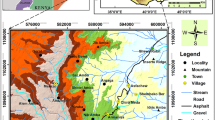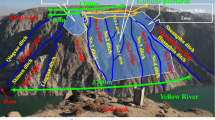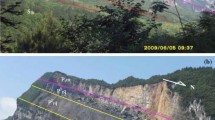Abstract
Localized high-strength rocks have an important influence on the stability and deformation characteristics of slopes. Understanding the excavation deformation mechanism of locking type slope can provide a basis for the management of locking section slope. In this paper, three sets of large-scale physical model tests were carried out to investigate the relationship between the length of the locking section and the evolution of slope destabilization, taking the typical locking slope of section K126 of Chenning Expressway in Hunan Province as an example. In addition, FLAC3D was used to simulate the deformation characteristics of slope excavation with different lengths of locking segments to investigate the influence of the length of locking segments on the stability of slopes. The results show that the length of the locking segment has a significant effect on the deformation characteristics and destabilization mechanism of the slope. The destabilization of slopes without locking segments is manifested as an overall driving progressive damage of multi-stage slip surface. When the length of the locking section is shorter, the destabilization of the slope manifests as a rotationally pushed progressive damage. When the locking section length is longer, the stability is higher and the slope undergoes only shallow progressive failure with shallow slip surface. These results can provide a scientific basis for the design of slope stabilization in the locking section.
Similar content being viewed by others
References
Ahmed Z, Wang S, Hashmi MZ (2020a) Causes, characterization, damage models, and constitutive modes for rock damage analysis: A review. Arabian Journal of Geosciences 13:806, DOI: https://doi.org/10.1007/s12517-020-05755-3
Ahmed Z, Wang S, Hashmi MZ (2020b) Failure analysis of rock cut slope formed by layered blocks at Fort Munro, Pakistan. Arabian Journal of Geosciences 13:338, DOI: https://doi.org/10.1007/s12517-020-05347-1
Ahmed Z, Wang S, Jasim OH, Xu Y, Wang P (2020c) Variability effect of strength and geometric parameters on the stability factor of failure surfaces of rock slope by numerical analysis. Arabian Journal of Geosciences 13, DOI: https://doi.org/10.1007/s12517-020-06080-5
Chen Z, Song D (2020) Numerical investigation of the recent Chenhecun landslide (Gansu, China) using the discrete element method. Natural Hazards 105:717–733, DOI: https://doi.org/10.1007/s11069-020-04333-w
Chen Z, Song D (2023) Modeling landslide susceptibility based on convolutional neural network coupling with metaheuristic optimization algorithms. International Journal of Digital Earth 16(1):3384–3416, DOI: https://doi.org/10.1080/17538947.2023.2249863
Cheng QG, Hu HT, Peng JB (2018) Analysis of the dynamics of flank-locking planar rotational landslides. Journal of Rock Mechanics and Engineering 19(05):634–639
Cheng QG, Zhang JY, Cui P (2004a) Mechanical mechanism and stability criterion for the initiation of a rotational tangential laminated rock slide with a central “mainstay” locking plane. Journal of Rock Mechanics and Engineering 23(16):2718–2725
Cheng QG, Zhang ZY, Huang RQ (2004b) Kinetic mechanism and stability criterion of tangentially laminated rock slide with composite locking of flank and slide bed. Journal of Rock Mechanics and Engineering 23(11):1874–1882
Huang RQ (2004) Study on the dynamic process and typical deformation and damage mechanism of rocky high slope development in western China. Eighth National Conference on Rock Mechanics and Engineering, October 1, Chengdu, China
Jiang T, Jia H, Lei JH (2020) Physical model tests on the deformation evolution characteristics of supported-arch locking landslides. Journal of North China Institute of Water Resources and Hydropower 41(2):88–96
Jiang T, Lei JH (2018) Test method of locking landslide model based on image correlation analysis. Journal of North China University of Water Resources and Hydropower (Natural Science Edition) 39(6): 41–45
Li DD (2020) Experimental study on the evolutionary mechanism of rainfall-induced locked landslides in west Henan. PhD Thesis, North China University of Water Resources and Hydropower, Zhengzhou, China
Liu HD, Li DD, Wang ZF, Geng Z, Li LD (2020) Physical modeling on failure mechanism of locked-segment landslides triggered by heavy precipitation. Landslides 17(2):459–469, DOI: https://doi.org/10.1007/s10346-019-01288-3
Liu AH, Wang SJ (1994) Progressive damage model for planar slopes and its application. Journal of Engineering Geology 2(1):1–8
Liu HD, Zhang YB, Lu LP (2018) Study on the type of locked landslide in west Henan. Journal of North China University of Water Resources and Hydropower (Natural Science Edition) 39(6):1–7
Luo G (2010) Study on the mechanism of river blockage and dam failure of Tangjiashan high-speed landslide. PhD Thesis, Southwest Jiaotong University, Chengdu, China
Mu CL, Pei XJ, Wang RW (2022) Deformation and damage characteristics analysis of high slopes with multi-layered soft interlayer down-excavation based on physical model test. Chinese Journal of Geological Hazards and Prevention 33(3):61–67
Qin SQ, Wang YY, Ma P (2010) Exponential law for the evolution of critical displacement of landslide hazard. Journal of Rock Mechanics and Engineering 29(5):15–22
Song D, Chen Z, Ke Y, Nie W (2020a) Seismic response analysis of a bedding rock slope based on the time-frequency joint analysis method: A case study from the middle reach of the Jinsha River, China. Engineering Geology 274:105731, DOI: https://doi.org/10.1016/j.enggeo.2020.105731
Song D, Liu X, Chen Z, Chen J, Cai J (2020b) Influence of tunnel excavation on the stability of a bedded rock slope: A case study on the mountainous area in Southern Anhui, China. KSCE Journal of Civil Engineering 25:114–123, DOI: https://doi.org/10.1007/s12205-020-0831-6
Tan WH, Wang JC, Zhou RD (2020) Physical and numerical simulations of progressive damage of rock slopes. China Mining 9(5):9–10
Tang P (2021) “Creep-slip-tension-shear” type locking. Study on the critical depth and stability of rim pulling crack. PhD Thesis, Chengdu University of Technology, Chengdu, China
Troncone A, Conte E, Donato A (2014) Two and three-dimensional numerical analysis of the progressive failure that occurred in an excavation-induced landslide. Engineering Geology 183:265–275, DOI: https://doi.org/10.1016/j.enggeo.2014.08.027
Troncone A, Pugliese L, Conte E (2022) Analysis of an excavation-induced landslide in stiff clay using the material point method. Engineering Geology 296:106479, DOI: https://doi.org/10.1016/j.enggeo.2021.106479
Wang S, Ahmed Z, Hashmi MZ (2019) Cliff face rock slope stability analysis based on unmanned arial vehicle (UAV) photogrammetry. Geomechanics and Geophysics for Geo-Energy and Geo-Resources 5:333–344, DOI: https://doi.org/10.1007/s40948-019-00107-2
Wang S, Ahmed Z, Wang P (2021) Study of critical failure surface influencing factors for loose rock slope. SN Applied Sciences 3:65, DOI: https://doi.org/10.1007/s42452-020-04108-9
Wang YS, Zhao B, Li J (2017) Mechanism of the catastrophic June 2017 landslide at Xinmo Village, Songping River, Sichuan Province, China. Landslides 15(2):333–345, DOI: https://doi.org/10.1007/s10346-017-0927-3
Xiao SR, Liu DF, Hu ZY (2010) Study on the high-speed sliding mechanism of the Qianzhongping landslide in the Three Gorges Reservoir. Geotechnics 31(11):3531–3536, DOI: https://doi.org/10.16285/j.rsm.2010.11.009
Zhong XY, Liu BW, Chen JB, Wang ZW, Wang YC (2021) Study on deformation characteristics of slope excavation and parameter optimization of soft rock and bedding slope in open-pite. Coal Engineering 53(3):151–155
Zou ZX, Tang HM, Xiong CR (2014) High-speed rocky landslide initiation elastication acceleration mechanism and calculation of elastication velocity—Jiwei Mountain landslide in Wulong County as an example. Geotechnical Mechanics 35(7):2004–2012, DOI: https://doi.org/10.16285/j.rsm.2014.07.014
Acknowledgments
We thank James Buxton MSc, from Liwen Bianji (Edanz) (www.liwenbianji.cn/), for editing the English text of a draft of this manuscript.
This study was supported by the National Key R & D Projects (No. 2019YFC1509704), NationalNatural Science Foundation of China (No. U1704243), the Project of High level talents in North China Universityof Water Resource and Electric Power (No.202010013), Key scientific research projects of collegesand universities in Henan Province (23A410002), Postgraduate Education Reform and Quality ImprovementProject of Henan Province (YJS2022JD02, YJS2022AL006).
Author information
Authors and Affiliations
Corresponding author
Rights and permissions
About this article
Cite this article
Xiaochao, L., Dongdong, L., Wei, G. et al. Deformation Evolution Characteristics and Destabilization Mechanism of Locked Slope Excavation. KSCE J Civ Eng (2024). https://doi.org/10.1007/s12205-024-1120-6
Received:
Revised:
Accepted:
Published:
DOI: https://doi.org/10.1007/s12205-024-1120-6




